Flaky Sourdough Croissants – With Step by Step Instructions
A step-by-step recipe for easy sourdough croissants. The end result is buttery, flaky pastries, sure to impress.
Sourdough croissants are deliciously buttery, flaky and once you make them you can’t help but feel darn proud. Making croissants with the sourdough starter is a pretty drawn-out process, but it is not actually difficult. In this post, I will show you step by step how to make this sourdough pastry recipe.

The process is spread out over two days so the main thing you need is time.
These croissants are best made in an environment where the room temperature is not too hot. The trick to flaky layers in the dough is to keep the butter cool as it is rolled into the dough. If it melts into the dough, it won’t be laminated correctly.
If your room temperature is above 25°C/77°F you may struggle to keep the dough and butter cool.
The starter
In the morning, feed your sourdough starter. You’ll need 150g of fed and active sourdough starter at 100% hydration for these sourdough croissants. 100% hydration means there are equal weights of flour and water used when feeding the starter.
To get great and consistent results it’s important that you use an active starter that has a low acid content.
If you refresh your starter regularly and use a small amount of seed starter each time, this can slow the acid build-up.
I like to use the feeding ratio of 1:2:2, (1 part starter, 2 parts flour, and 2 parts water measured in weight).
I refresh my starter like this very often, in a clean jar. This brings a fairly small amount of seed starter into the new mix, with double the amount of fresh flour and water.
For this dough, it could be 40g starter, 80g flour, and 80g water. This will make approximately 200g starter. 150g can be used for the dough, and the remaining starter can be fed again 1:2:2 and stored the next time you need it. See more about maintaining a starter.
At a room temperature of between 21-23°C, a starter that’s ready will double, if not triple, easily within 6 hours at that ratio. Use your starter before it passes its peak and starts to collapse. If used after this point, it will likely be too exhausted and acidic to give good results. Read more about acid content in starters.

The pastry dough
When the starter is ready to use, combine the flour, water, salt, sugar, sourdough starter, and butter in a bowl. Mix it together by hand to create a sticky ball of dough.
Give it a knead for 5-8 minutes to create a smooth ball, though it will still be sticky. Place it in a greased bowl.
Leave the dough out for 3 hours to ferment, ideally at room temperature between 23-25°C/74-77°F. If your room is cooler than this, leave it for 4 hours. The dough should be slightly puffier after the ferment.
Afterward, transfer it to the refrigerator overnight.
At this point, leave out 250 grams of butter for tomorrow’s step so it is at room temperature for when you need it.
Butter Packet
In the morning, take the butter that was left out overnight and mix it with some flour to create a butter mixture that is nice and malleable.
Roll this butter mixture out between two sheets of baking paper into a rectangle of about 15 x 20cm (6x8inch.)
Place the butter in the fridge for a few minutes to cool. Ensure it is cool but still pliable.
If the butter is too cold and stiff, it’s going to shatter in the dough when it’s rolled out which can create uneven layers. Aim for the butter and the dough to be similar consistencies.
Gauging the exact temperature of the butter packet so that it is a similar consistency to the dough is something that gets better with practice.
Lamination
Now, on a floured bench, roll out yesterday’s dough into a 20x40cm(8x16inch) rectangle.
Once the butter is cool again, place it in the middle of the dough. Bring the top of the dough down and the bottom of the dough up to meet in the middle and tuck in the butter.
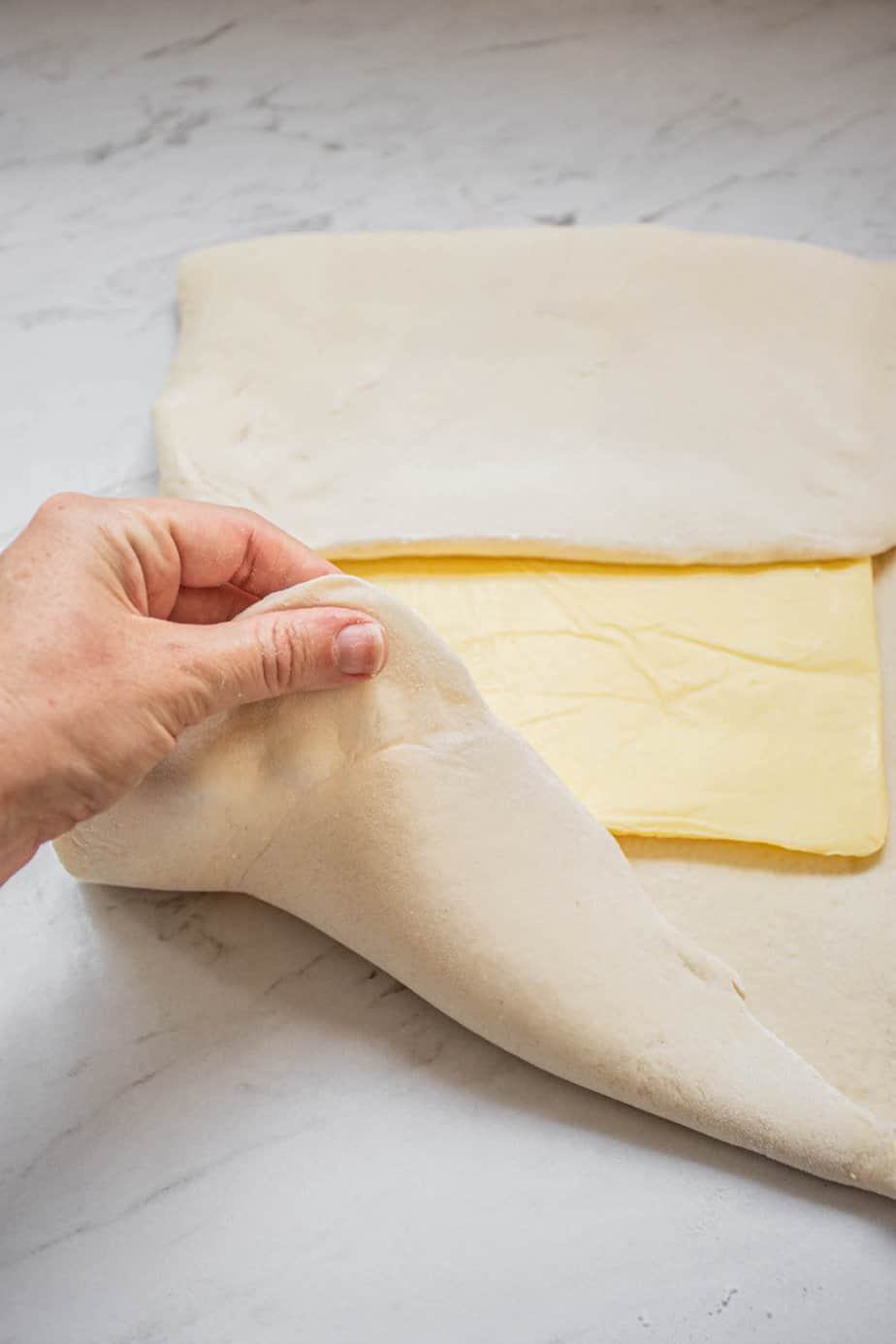
Turn the dough a quarter turn. Use a rolling pin to gently push on the dough to help disperse the butter.
The butter should just be cool but not rock hard. Keeping the butter and the dough at similar consistencies is key. If the butter is too firm and brittle it won’t incorporate into the dough well.
However, ensure it doesn’t warm and softens too much. Cold butter is what will give the flaky layers in the croissants. If the butter melts into the dough, you’ll end up with bread-like croissants with no layers.
Fold 1
Roll this dough out in front of you into a rectangle that’s around 25x50cm (10x20inch), focus on lengthening the dough rather than making it wider. While rolling, check that the dough isn’t sticking to the bench and dust with flour if it is.
Fold the dough like a pamphlet by bringing the top third down to the middle and then bringing the bottom third up overtop.
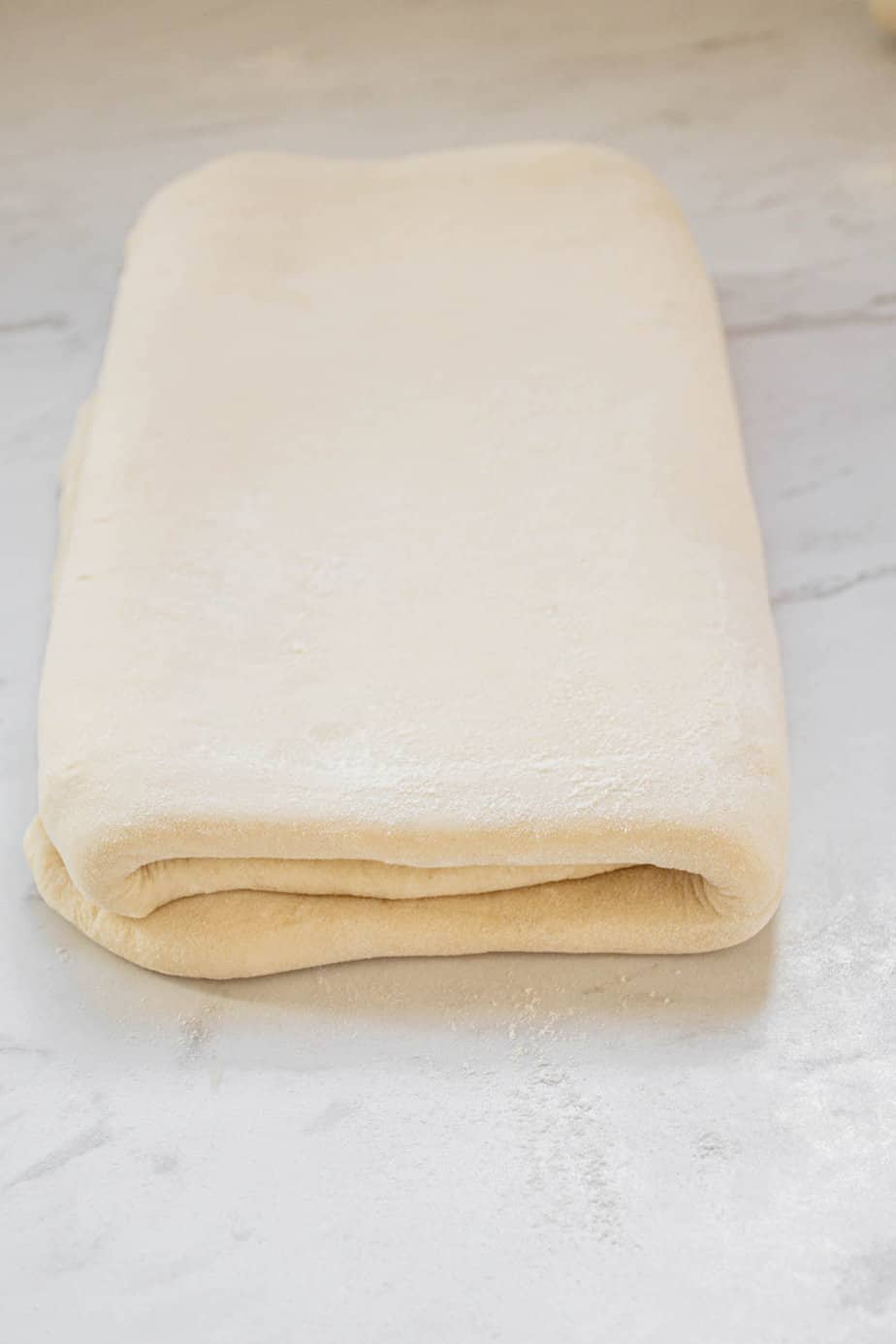
Wrap the dough up (I use the baking paper used for the butter) and let the dough rest for 30 minutes in the fridge. If your kitchen is on the cold side, the dough can rest on the bench.
Again, you want the butter and the dough to be similar consistencies, but don’t let the butter warm up.
Fold 2
Turn the chilled dough 90 degrees and roll it out in front of you into another 25x50cm (10x20inch) rectangle. At this point, you can cut off any scraggly edges, which will help give you more even layers later on. Repeat the folding process. Place it back in the fridge for 20-30 minutes.
Fold 3
Repeat this step once more. After this fold, chill the dough for at least 2 hours.
Shaping
Roll the chilled dough into a 28x60cm (11x24inch) rectangle.
Mark 5cm (2inch) marks along both lengths of the dough rectangle. Use a pizza cutter or large knife to cut triangles that connect the marks from the top to the bottom. Using a ruler can really help keep your lines straight.

Make a little cut in the bottom of each triangle and stretch it out. Then roll the triangles up tightly, starting from the bottom and rolling to the tip. You can bed the ends of croissants a little to make a crescent, or leave them straight.

You can also make pain au Chocolat with croissant dough or Cruffins and Danish pastries.
Leave the rolled croissants to proof on parchment paper-lined trays for around 4 hours at a temperature between 23-25°C/74-77°F. They should become puffy and jiggle when the tray is gently shaken. The layers in the croissant should be visible.
You can brush the croissants with a little water to stop them from drying out or create a humid and warm spot by placing the croissants in a turned-off oven next to a cup of hot water.
Ensure the butter in the croissants doesn’t melt or it will ruin the layers.
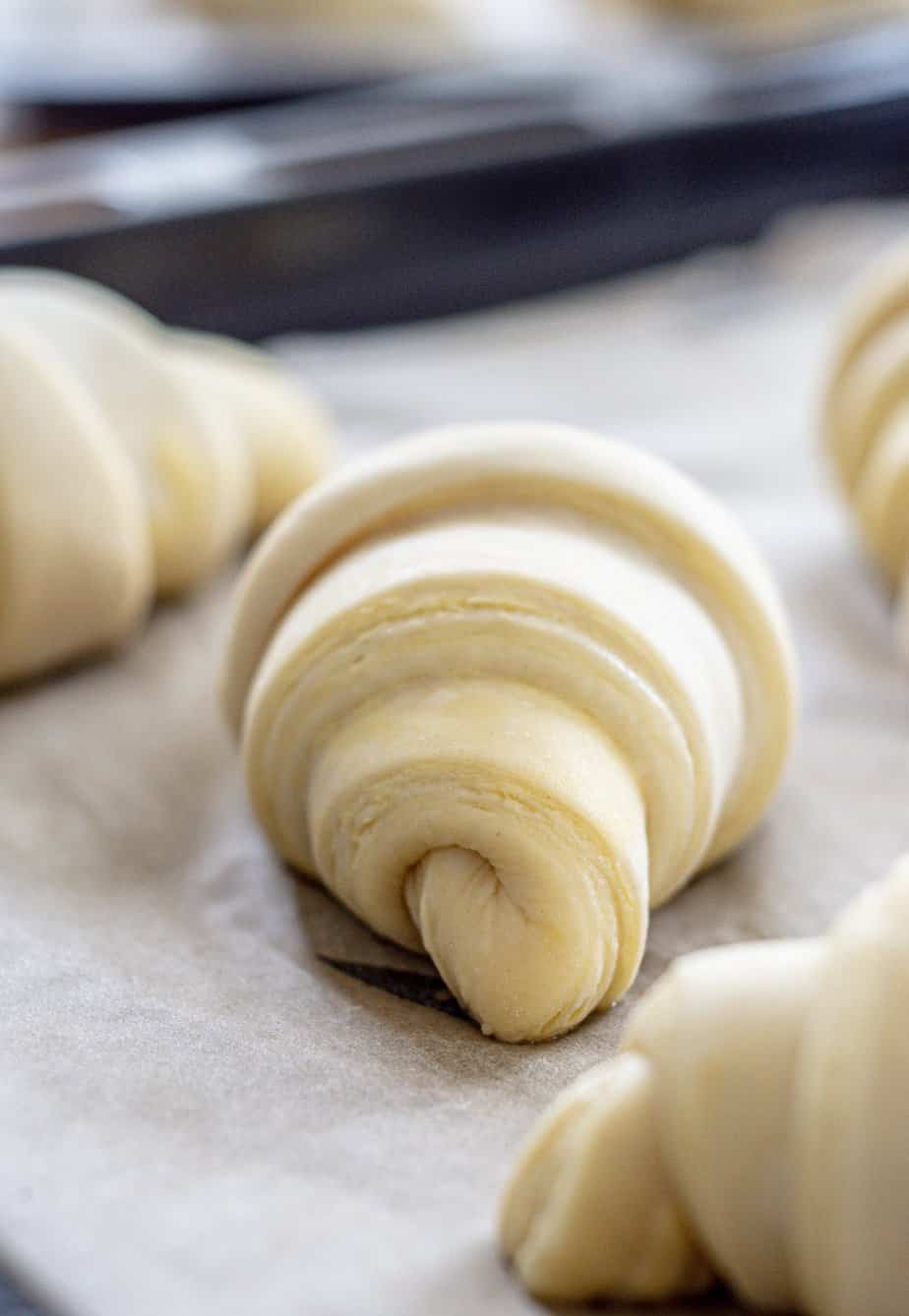
Baking
The croissants can be baked once they have puffed out, or they can be refrigerated if you want to bake them in the morning. The extended fridge time will increase the sour flavor.
Preheat the oven to 205°C/400°F. Brush the croissants with egg wash.
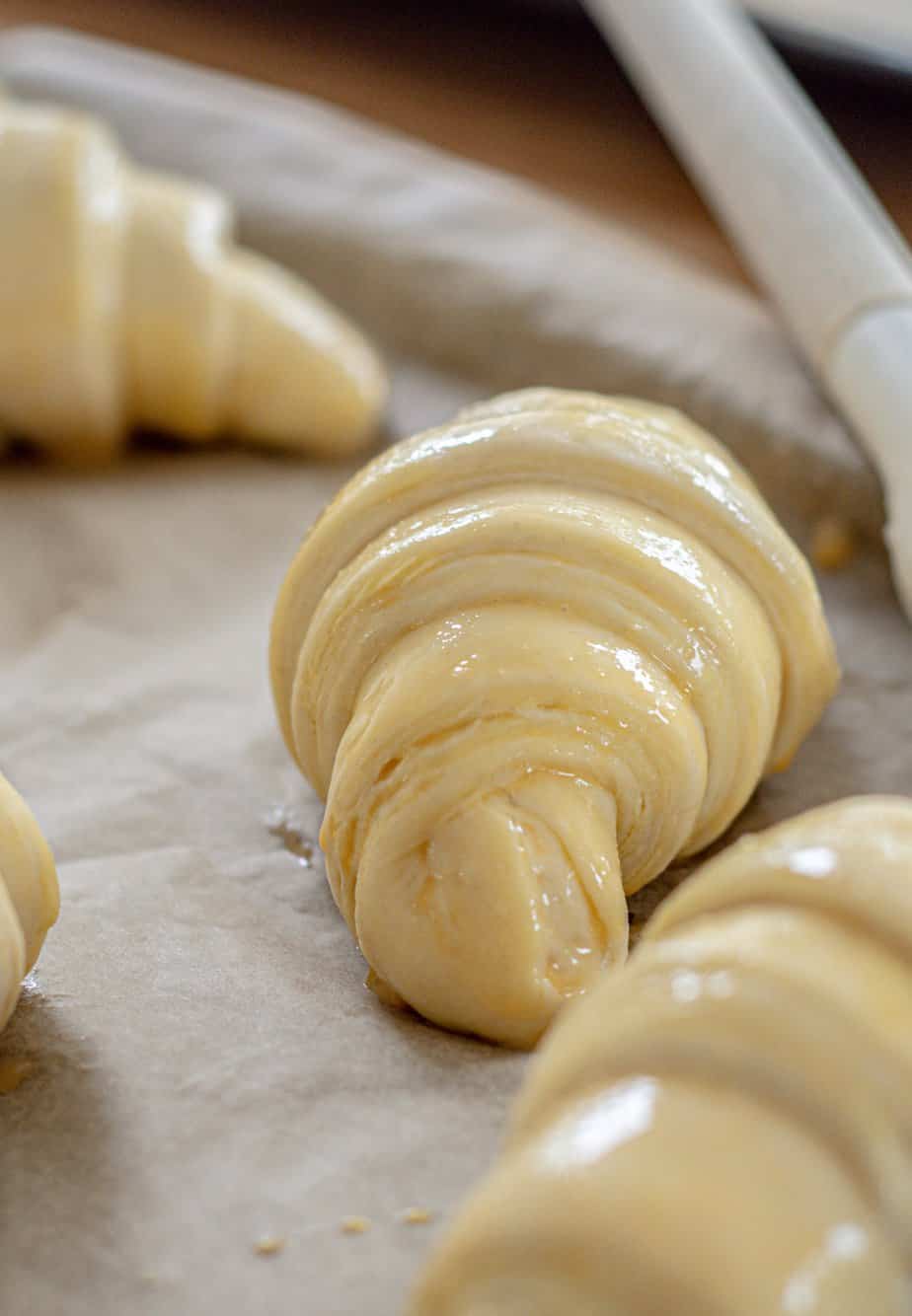
Bake them in a hot oven for around 20 minutes until deeply browned. If they are browning too quickly, you can turn down the oven temperature a bit.
Storing
Croissants are great served fresh on the day they are baked. The layers in the croissants will be most prominent if the croissant has cooled down to room temperature before slicing.
Leftover croissants can be stored in an airtight container at room temperature for up to 4 days, or frozen for up to three months.
Freezing croissant dough
Unbaked croissants can be frozen after they have been shaped and proofed. This way they have already done all their rising and can be baked from frozen.
I have a Youtube video on sourdough croissants however it has been a few years since this video was made and my technique and methods have slightly changed.

Related recipes
Try these other sourdough recipes –
- Easy sourdough focaccia
- Chocolate Sourdough Bread
- Sourdough garlic knots
- Cruffins with sourdough starter
- Sourdough fougasse
Love lamination? Try this inverse puff pastry, or if you’re short on time here’s a rough puff pastry!

Step by Step Sourdough Croissants
An easy sourdough croissant recipe. Makes between 10-12 croissants, depending on size.
Ingredients
Starter (makes approx. 200g starter. Leftover started can be fed and used for the next time you bake)
- 40g starter
- 80g flour
- 80g water
Dough Ingredients:
- 450g all-purpose flour
- 1 tsp salt
- 40g sugar
- 230ml water
- 150g doubled sourdough starter
- 50g unsalted butter, room temperature
Butter packet:
- 250g unsalted butter, room temperature
- 1 1/2 Tablespoons flour
Egg Wash
- 1 egg + 1 tbsp water
Instructions
Starter
- In the morning, feed your starter by combing the starter, flour, and water in a bowl and mixing it until well combined. Tip it into a clean jar or glass and let it double or triple.
The dough
- Prepare the dough by mixing together all the dough ingredients and using your hands to form a sticky dough ball. Knead the dough on the bench for 5-8 minutes until you create a smooth ball.
- Cover the dough in a greased bowl, covered with a damp towel. Leave the dough out for 3 hours to ferment, ideally at room temperature between 23-25°C/74-77°F. If your room is cooler than this, leave it for 4 hours. The dough should be puffier after the ferment.
- Place the covered bowl in the fridge overnight.
Laminating
- In the morning, mix 1 1/2 tablespoons flour and 250g butter. Spoon the mix onto parchment paper and place another sheet on top. Roll the butter into a rectangle of about 15 x 20cm (6 x 8 inches). Place the butter in the fridge for around 10 minutes so it is cool. Ensure it is cold but still pliable. Aim for the butter and the dough to be similar in consistency.
- Take the dough from the fridge and, on a floured bench, roll it into a 20x40cm(8x16 inch) rectangle.
- Once the butter is cool again, place it in the middle of the dough. Bring the top of the dough down and the bottom of the dough up to meet in the middle, and tuck in the butter.
Fold 1
- Turn the dough a quarter turn. Use a rolling pin to gently push on the dough to help disperse the butter. Roll this dough out into a 25x50cm (10x20inch) rectangle, and focus on lengthening the dough rather than making it wider. While rolling, dust the dough with flour to stop it sticking to the bench.
- Brush away the excess flour from the dough. Fold the dough like a pamphlet by bringing the top third down to the middle, and the bottom third up overtop.
- Wrap the dough up (I use the baking paper I used for the butter) and let the dough rest in the fridge for 30 minutes. *If your kitchen is colder, the dough can rest on the bench. However, it is important not to let the butter melt or warm up.
Fold 2
- Turn the chilled dough 90 degrees and roll it out in front of you into a 25x50cm (10x20 inch) rectangle. At this point, you can cut off any scraggly edges, which will help give you more even layers later. Repeat the folding process. Place it back in the fridge for 20-30 minutes.
Fold 3
- Repeat this step once more. After this fold, chill the dough for at least 2 hours.
Shaping
- Roll the chilled dough into a 28x60cm (11x24 inch) rectangle on a floured bench.
- Mark 5cm (2 inches) marks along both lengths of the dough rectangle. Use a pizza cutter or large knife to cut triangles that connect the marks from the top to the bottom. Using a ruler can help keep your lines straight.
- Make a little cut at the bottom of each triangle and stretch it out. Then, roll the triangles up tightly, starting from the bottom and rolling to the tip. You can bed the ends of croissants a little to make a crescent or leave them straight
- Leave the rolled croissants to proof on parchment paper-lined trays for around 4-5 hours at a temperature between 23-25°C/74-77°F. They should become puffy and jiggle when the tray is gently shaken. The layers in the croissant should be visible.
- You can brush the croissants with a bit of water to stop them from drying out or create a humid and warm spot by placing them in a cold oven next to a cup of hot water. Ensure the butter in the croissants doesn't melt or it will ruin the layers. Don’t place the cup of hot water underneath the tray of croissants, or it’ll make the bottom of the tray too warm.
Baking - The croissants can be baked once they have puffed out or refrigerated if you want to bake them in the morning. The extended fridge time will increase the sour flavor.
- Preheat the oven to 205°C/400°F.
- Mix the egg and water together in a small bowl. Use a pastry brush to brush the croissants with egg wash.
- Bake the croissants for around 20 minutes until deeply browned.
Storing
- Croissants are great served fresh on the day they are baked. The layers in the croissants will be most prominent if the croissant has cooled down to room temperature before slicing.
Notes
- If the croissants leak a lot of butter in the oven, the dough may be under-proofed. The texture of an under-proofed croissant can be gummy and appear undercooked.
- If the croissants take on a bread-like texture, the butter may have melted into the dough during lamination. It is important it stays cool while it is rolled in.
Freezing croissant dough
Unbaked croissants can be frozen after they have been shaped and proofed. This way they have already done all their rising and can be baked from frozen.
Recommended Products
As an Amazon Associate, a Mighty Ape affiliate and member of other affiliate programs, I earn from qualifying purchases.
Nutrition Information:
Yield: 10 Serving Size: 1 gramsAmount Per Serving: Calories: 526Total Fat: 26gSaturated Fat: 15gTrans Fat: 0gUnsaturated Fat: 9gCholesterol: 83mgSodium: 246mgCarbohydrates: 64gFiber: 2gSugar: 4gProtein: 9g
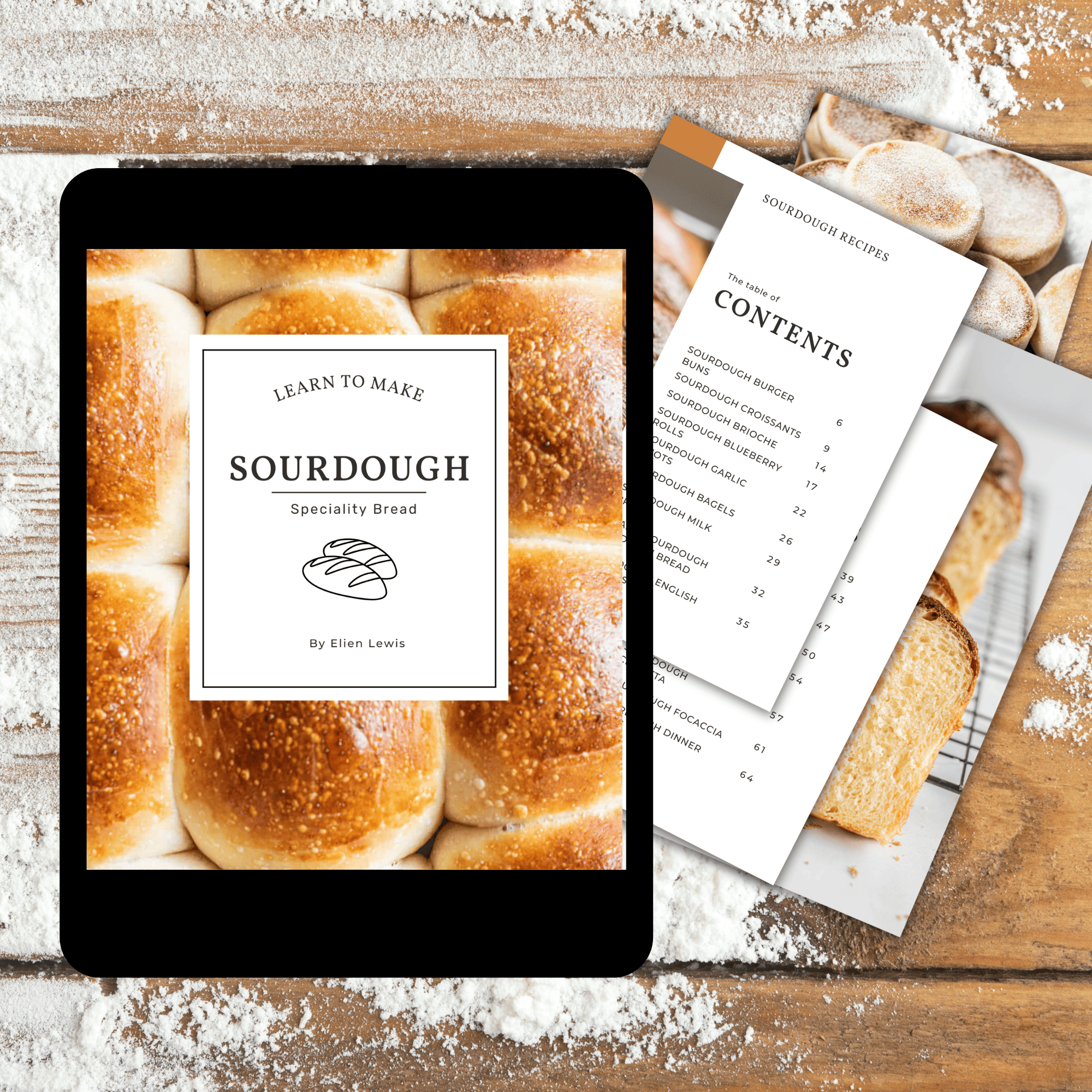

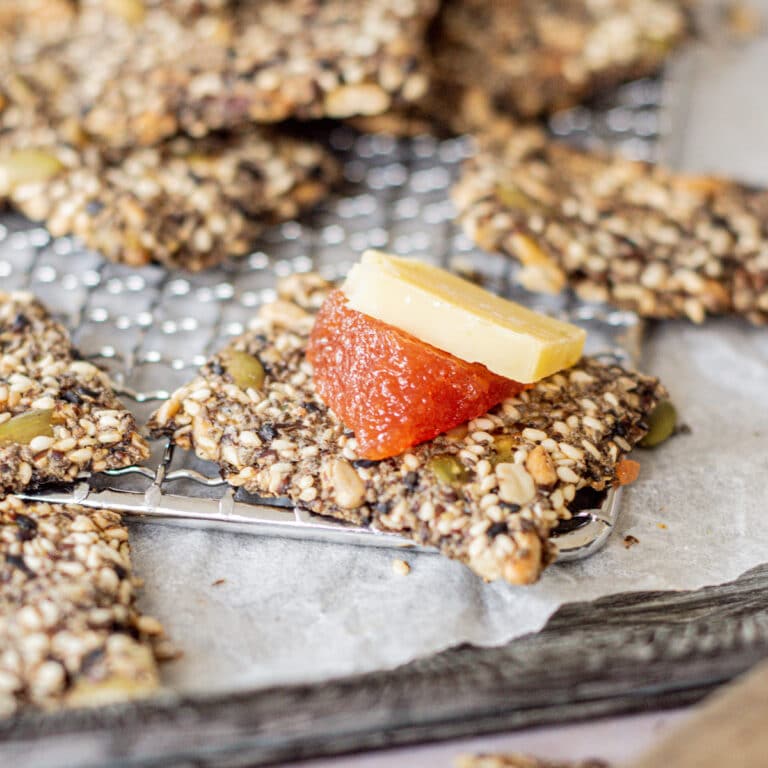


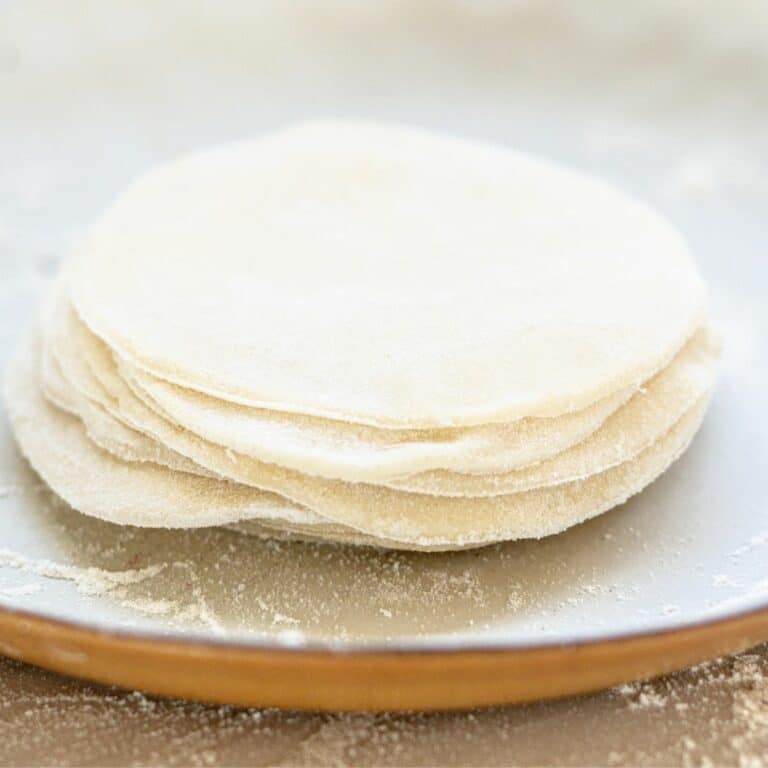


What time should I start mixing the dough so it doesn’t overproof over night?
I usually start mine in the afternoon, around 2ish, once my starter has risen 🙂
Why no milk in the recipe for this dough, versus other recipes (including your sourdough cruffin dough recipe)?
It’s just a personal preference 🙂 you can use milk in this recipe if you want
What would be the measurements if we wanted to use milk or do we just replace all of the water with it
You can replace some or all of the water with milk 🙂
I live in the tropics where the average room temp is 30-32 degrees Celsius. How can I leave it to proof at room temp for 4-5hrs without the butter melting?
That’s going to be very difficult and I don’t recommend making croissants in those temperatures unfortunately
Hi! I lived in the tropics for years, and while it was more difficult than in a cooler climate, I did make croissants successfully. I made sure to do the rolling at the coolest time of day (usually early morning), and chill between each set of roll/fold. They probably would have never won a championship, but they were always delicious and everyone loved them.
For proofing, you have to gauge time by how the dough looks, and when it starts getting puffy you can pop it in the fridge. Depends on exact temperatures, but for me it was usually 2 hours or less.
For proofing, you have to gauge time by how the dough looks, and when it starts getting puffy you can pop it in the fridge. Depends on exact temperatures, but for me, when I lived in the tropics, it was usually 2 hours or less.
These were fantastic. But now I froze some of the proofed croissants. So how do I bake them when I’m ready to eat them? Is this better than freezing baked croissants
You can bake them right from frozen 🙂 I think both freezing options are good!
I love this recipe! I do have a question though. If I plan to make these croissants with stuffed meat, how would I do that? Would it be possible to roll and proof then unroll to stuff? I really don’t want to use store bought dough or another recipe. This is my favorite!
Hey, I don’t know if unrolling after proofing would work very well as it may deflate them too much. You could potentially proof strips or squares of dough, then fill and fold them after proofing. That might deflate them less than unrolling.
Hi, Just wondering if I can leave these in the fridge overnight so I can bake them for breakfast, Do I have to freeze them? Or are both options okay?
You can refrigerate them overnight and bake in the morning 🙂
Hi, what is the guidance if baking from frozen after rising?
They can be baked right from frozen but might need an extra minute or two
Quick question:
I’ve fermented the dough today. And it is in the refrigerator tomorrow.
Something has come up in the morning.
Could I possibly do the croissants the following day. The dough would be in the refrigerator 36 hours. Is that too long. I’ve enjoyed your recipes this week.
Thank you so much!
Hey Julie, I think it would still be okay to use! 🙂 I’m happy you’re enjoying the recipes!
It’s a pity I can’t post a picture of my pretty little rolls – putting them in the oven now – hold thumbs
I have been on a quest to make a perfect croissants for years! With this recipe I finally did it! Best croissants I’ve ever made or had!!
How do you bake them from frozen?
If they were proofed before freezing, you can simply bake them from frozen and add on a couple of extra minutes bake time if needed 🙂
This recipe is incredible. I’ve made it twice in the past few days, and it came out perfectly both times. I had always heard that 100% sourdough croissants didn’t rise well and thus needed a small amount of yeast. But these rose equally as high as any yeast croissant I’ve ever made: airy, perfectly flaky with a shatteringly crisp exterior…plus a depth of flavor that is a perfect backdrop to their butteriness. Elien, thank you so much for developing this recipe and sharing it!
Thank you so much for this wonderful feedback!! It’s so lovely to read! ☺️
How do you refrigerate these? Do they need to be covered? Or will they dry out?
Hey yes I cover with a damp, light kitchen towel, or I put them in a large container with a lid
Can this recipe be doubled?
Yes it can
Love croissants. Love using my sourdough starter for homemade things.
Hi Eileen,
Can I suggest as an old video producer that your videos would really benefit from better audio. This would mean a lavalier or neck mic for yourself which is plugged into your camera. There are lots of options out there – but it would make a huge difference to the overall presentation. Using only a camera mic means your audio is very echoey and difficult to understand.
Thanks
My dough is not coming together into a ball after 8 minutes in the mixer. It is still VERY sticky and wet. Am I safe to add more flour bit by bit? Thank you in advance!!
hey! yup go ahead and a tablespoon at a time if needed 🙂
Hi! Looking forward to trying this. If I want to add some chocolate inside (nutella?), what would be your recommendation? Can I just add a thin layer before I roll them up? Thanks!
Yup that’s what I would do too! 🙂
Hi! I am wondering what the dough is supposed to look like? Is it supposed to be sticky, or do you continue to knead until the stickiness starts to go away? Also, is the dough supposed to double before putting it into the fridge?
Thank you!!
Hey! it’s sticky when it’s first mixed, so knead it until it smoothens :). It doesn’t need to double before going into the fridge, just bulk out by around 40-50%
I’m excited to try these this week. All purpose flour? Not bread flour? Just plain flour? (I’m in Europe).
You want flour with around 11-12% protein so that might be bread flour where you are 🙂
Hi!
I have a question about the temp of the butter pamphlet and the dough. When I was doing my rolls and folds I noticed the butter was not smoothly creating layers, instead it was almost like the butter pamphlet cracked and I just have little butter slivers. I’ve just cut and rolled them but when I look I don’t see the distinctive layers. Could my dough have been to cold for my butter?
Hey Ashley, it sounds like the butter was too cold if it cracked. If you have a digital thermometer, the dough temperature should be around 40 F (4 Celsius), and the butter around 54 F (12 celsius). However not everyone has one, so I usually gauge it by feel. The butter should be bendy but not snap when you first laminate it into the dough. If it cracks while rolling, you can let it sit at room temperature for a bit to soften it slightly.
Hopefully you will still get some layers in your croissants despite the butter cracking though, they should show more once the croissants have proofed.
Just wondering if you can use vegan butter in this recipe?
Hey Tasha I’ve never tried it!